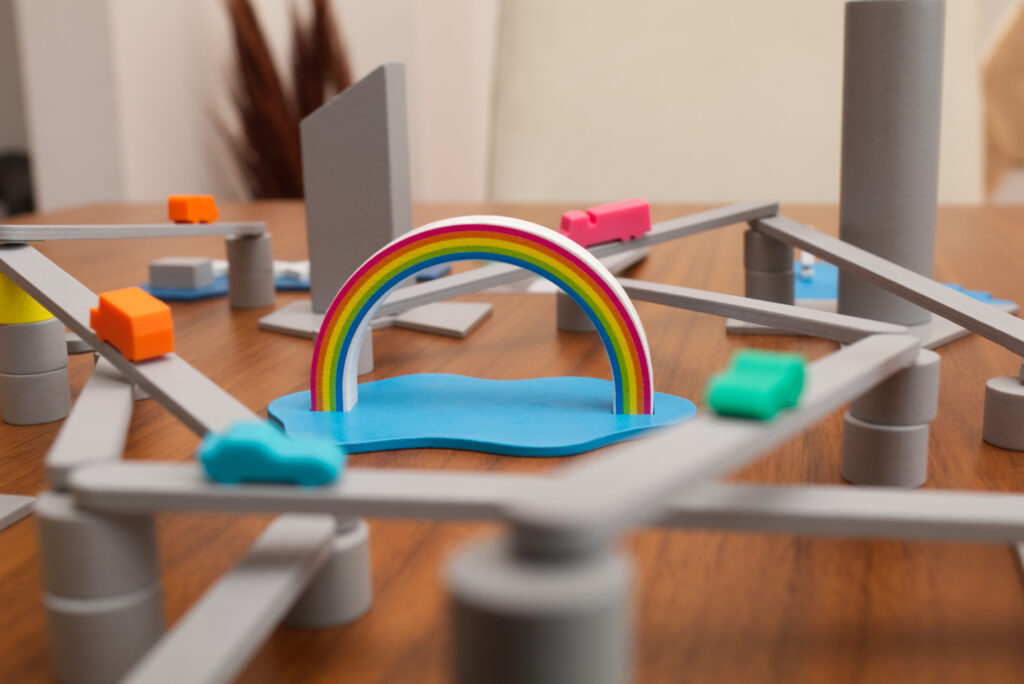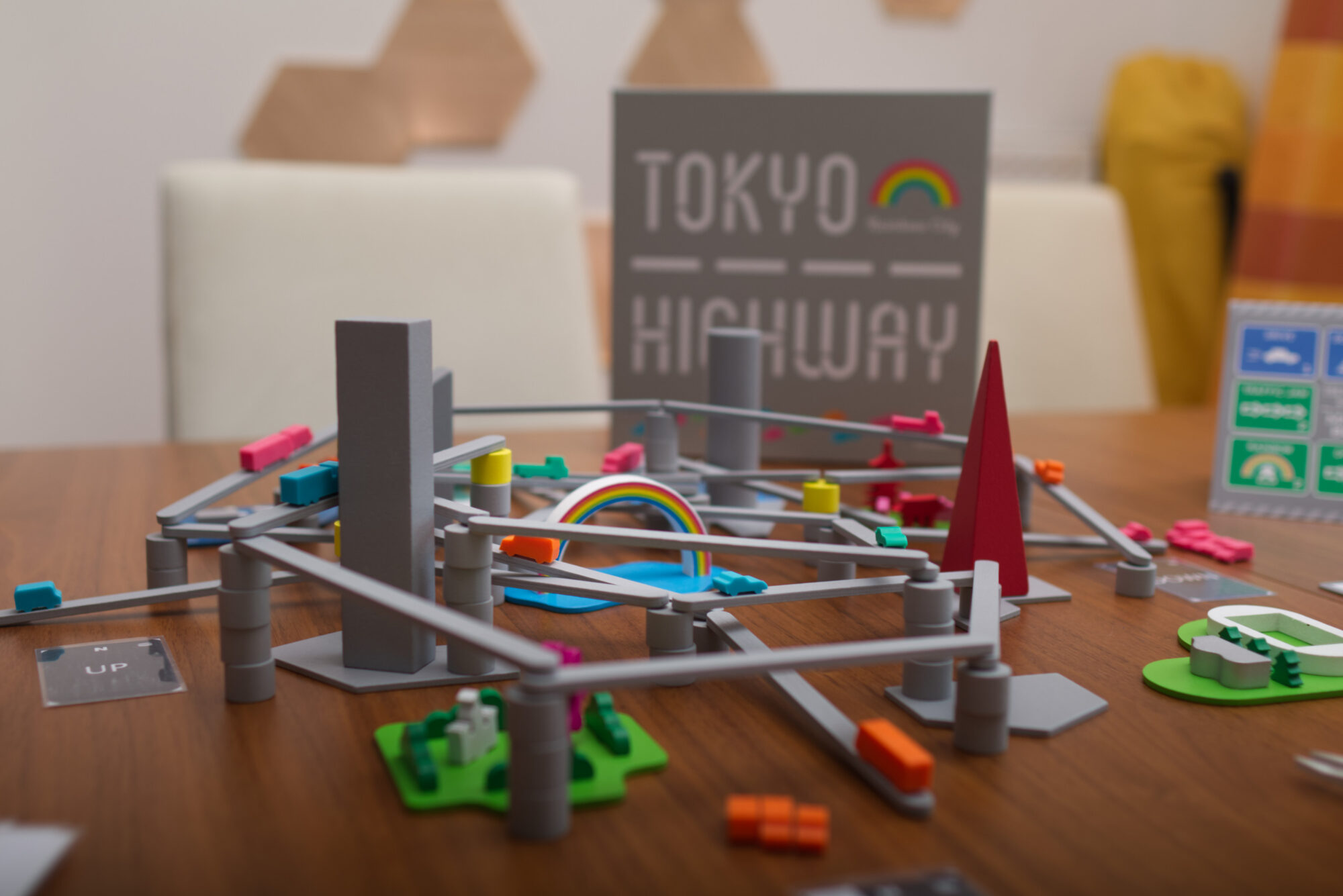I don’t even remember how I got to my copy of the original Tokyo Highway. It might have been on a board game flee market or something like that, but I’m sure I hadn’t seen it on YouTube and I hadn’t read a review. I picked up that grey Ticket-to-Ride-sized box, looked at the back of it and thought, ha, that’s cool … or I’m all wrong and I saw a picture on BGG and it looked fun, who knows. Point is, it’s been part of my collection for so long that I can’t even remember when and how I got it. I’m not a particularly big fan of dexterity games, but this one combined crazy fun building action with a minimalistic visual appeal of mostly grey with some colourful cars. And due to its building rules, things were certain to quickly get out of hand and produce ever more daring structures.
You can read all about my impressions for the original Tokyo Highway in my old review. I owned the four player European edition (there is also a tiny 2 player edition) that already came with four buildings that could be used as obstacles. I also later imported the expansion from Japan, which did cost me an arm and a leg. That one added different car types with special powers and a couple more obstacle buildings, also grey. The recently fulfilled Kickstarter project Rainbow City though isn’t just an expansion, but a completely overhauled new version of Tokyo Highway. Let me explain …
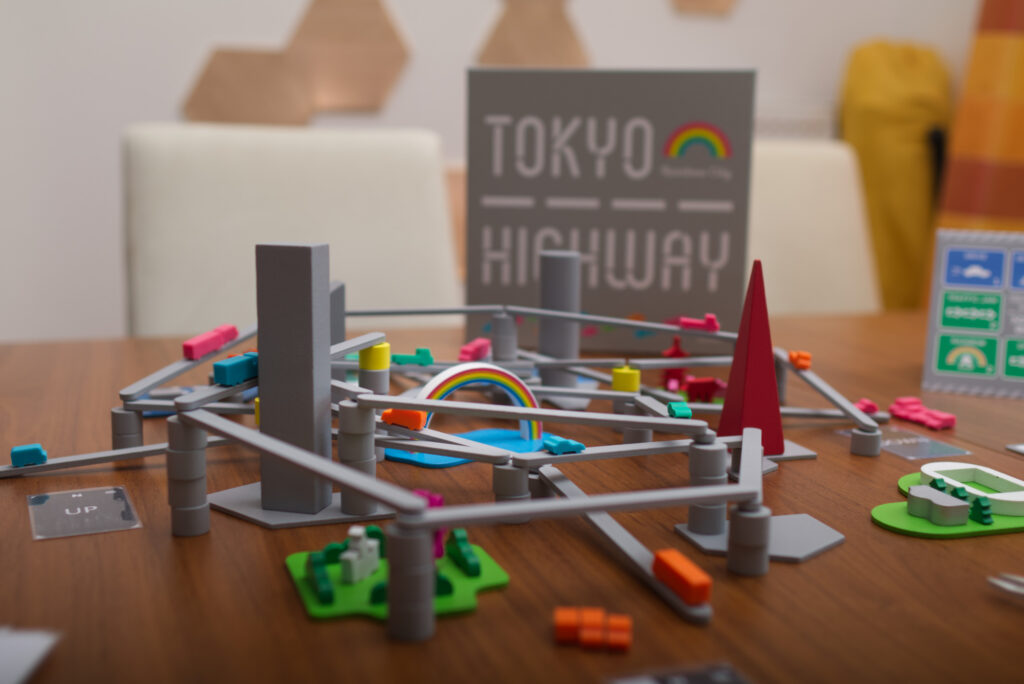
To Catch You Up
If you haven’t played Tokyo Highway before, here is the gist of it: each player starts with a starting road (marked with their first car) and gets a set of column tiles in the form of grey cylinders. When it’s your turn, take a new road segment and build one level up or down from where you road currently is. If you cross an opponent’s street and your street is either the lowest or the highest street crossing, you can place one of your 10 cars. Whoever places all their cars first wins.
Some important details: only the highest or lowest player crossing can place a car. So let’s say player A has a street that player B crossed over. Cross OVER player A’s street doesn’t place a car, but UNDER it still might. Crossing over player B’s street will place a car unless in the meantime someone else has crossed over that street as well. This forces players to do more and more daring manoeuvres to still be able to place cars. There is also a limited number of yellow junctions pieces which strategically can be placed to branch out and raise/lower the street by more than one level.
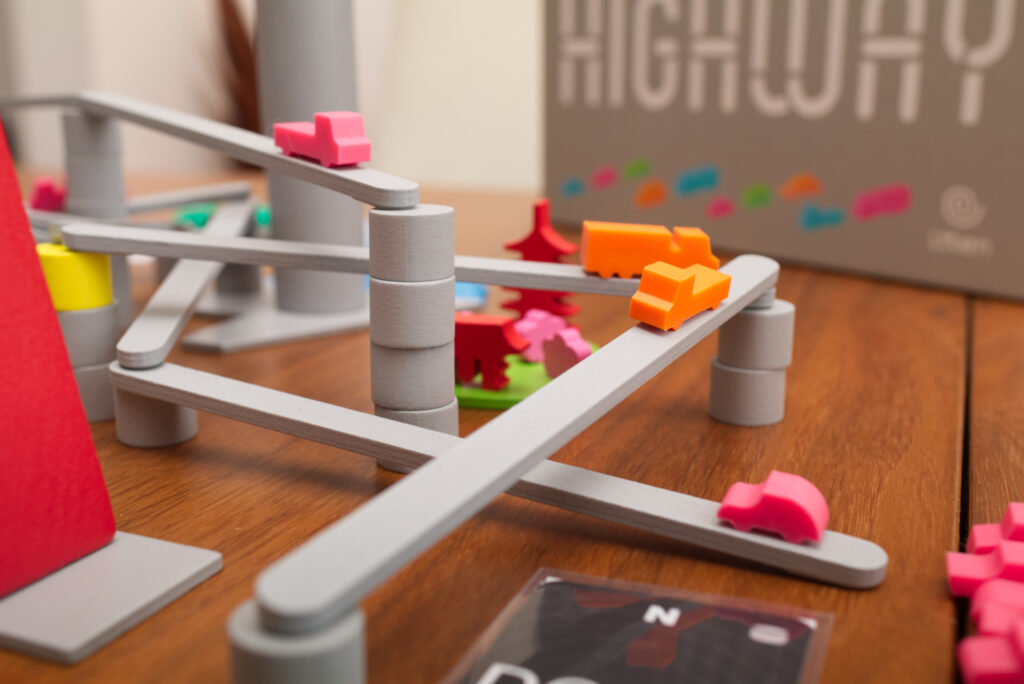
Added challenge: running out of columns. Each player only has a limited set of columns tokens, basically the currency of the game. If a player runs out of column tiles, that player automatically loses. If you knock down parts of the structure, you have to build it up and give each player whose pieces you knocked down some of your columns in reparations. So to sum up: cross other streets, cross highest or lowest, and try to not knock anything down.
More Buildings, More Colour, and On a Mission
The most noticeable change is that Tokyo got way more colourful. Especially when including all stretch goal contents, there is a lot going on. Water areas, sports centres, an airport, development areas, … When I first saw this at SPIEL Essen 2023, I wasn’t sure if I would like the look. The clean visuals of the original definitely had its pros. Having it now on my very own table, I quite like starting out immediately with more stuff going on, even before the first road segments are build.
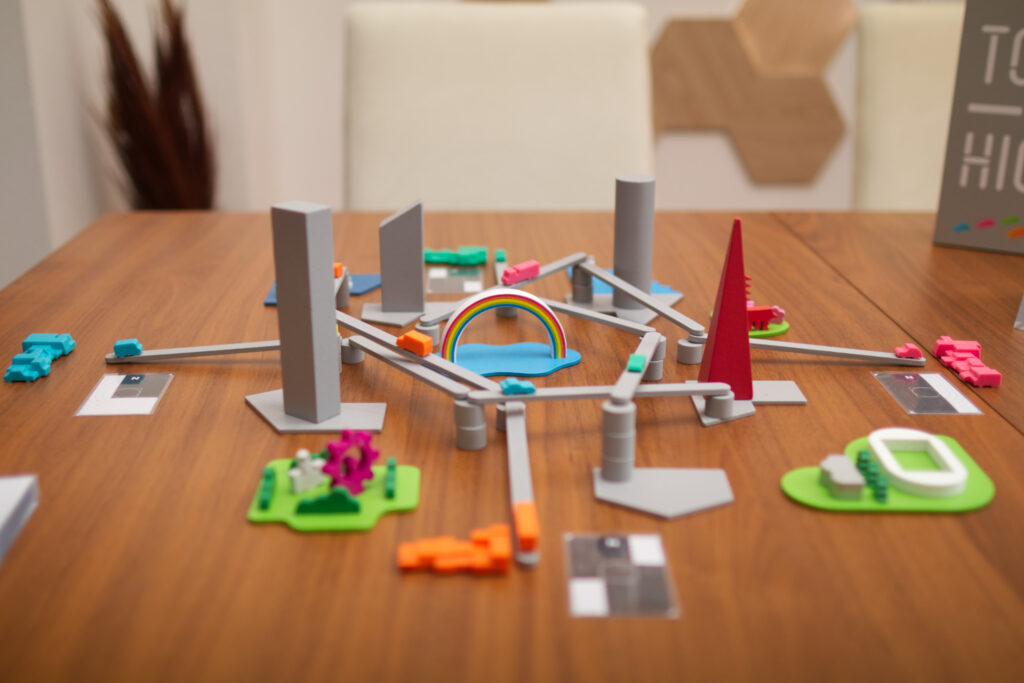
Mechanically speaking, the new elements can be used in two ways: the easiest mode is to use them simply as obstacles where columns cannot be placed on grass or water areas but grass and the grey development areas can be used for off-ramps, same as the table surface. For more advanced players, Rainbow City comes with a mission mode. Instead of winning by placing all cars, it’s now all about making the most points. Placing a car by crossing opponents streets as either highest or lowest street provides one point, but there are now all manors of additional to get additional points. Placing a column on a development area adds a point, getting three or more road segments with cars on them earns that player two points, crossing under the rainbow while placing a car adds two points, and so on. The game ends when any player has placed their last car or all road sticks have been placed. Whoever has the highest score wins.
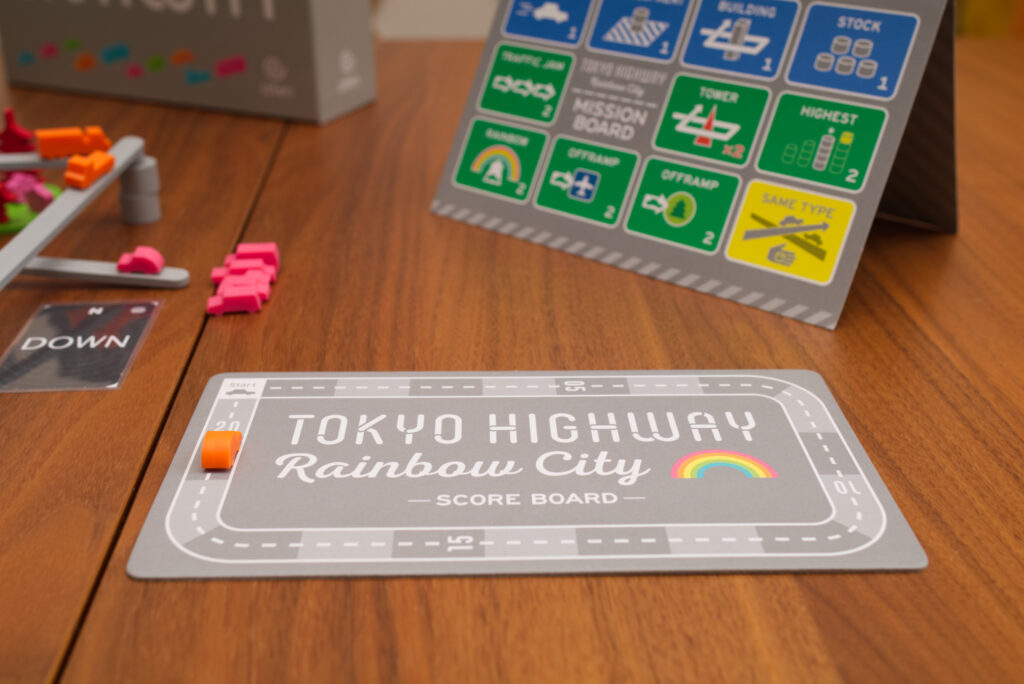
Different Car Types
For those familiar with the Tokyo Highway: Cars & Buildings expansion, there are again 10 different car shapes included but they don’t have special powers like in the expansion. Here, they are just used for one rule in the mission mode where if a player crosses a street and both have the same type of car on them, the player placing the street has to give a column to the other player. Otherwise, they are just there to make the city look more fun. To be honest, I don’t miss the special powers of the expansion. They sounded fun on paper but in reality Tokyo Highway neither needed them nor did they add much to the playing experience and I usually just used the building obstacles from that expansion.
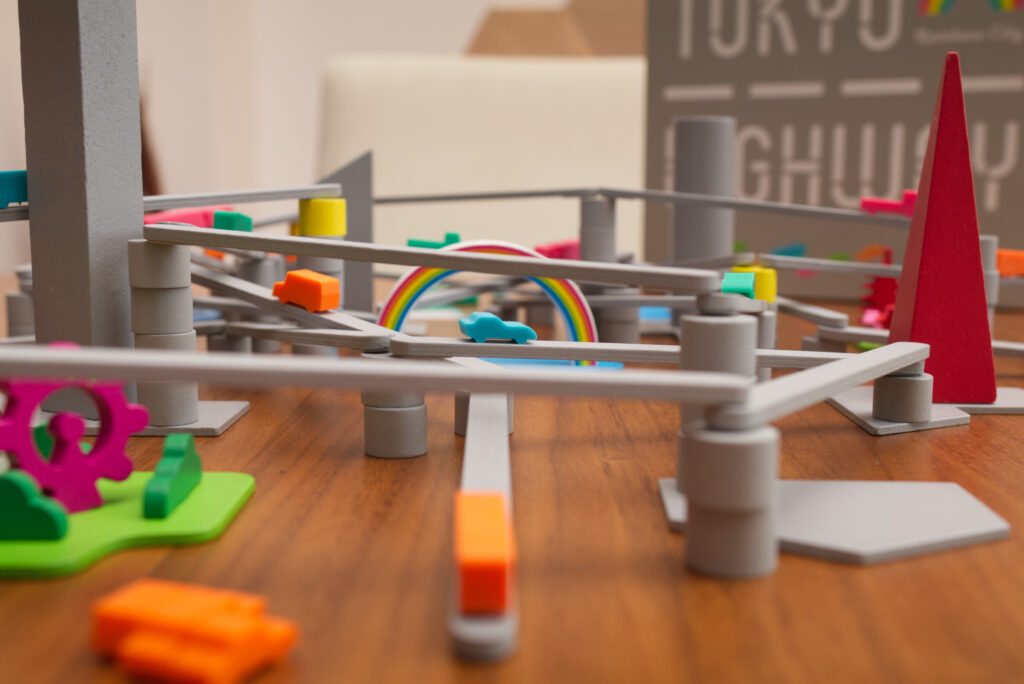
Wood vs Rubber
One of the biggest changes to Tokyo Highway is that now all cars are made of a hardened rubber instead of painted wooded and all street segments have small rubber pads at their bottom. The original Tokyo Highway could become quite unstable quickly as soon as players would use junctions to produce higher elevation roads or weird stacking of streets created crooked segments of the road. Sometimes you would build a legal road but couldn’t place a car on it because of the angle of the street. I just tried it: even a three step incline is next to impossible to place a car on in the wooden version as it will just slide off. With Rainbow City: five levels, no problem.
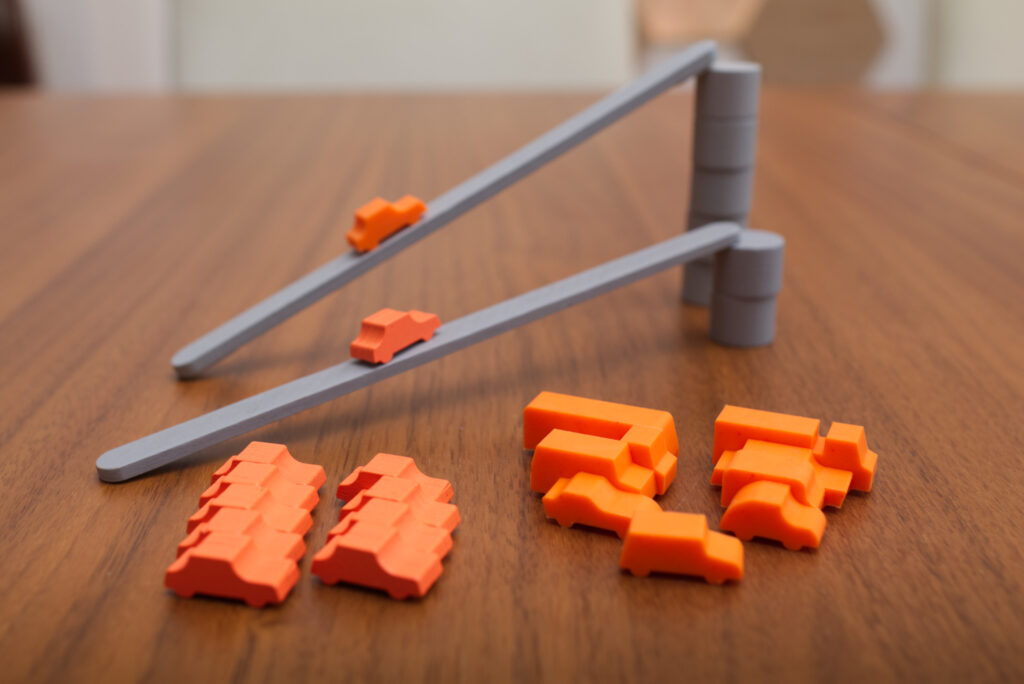
At first, I was unsure if I liked that change or not but got used to it very quickly. It’s still tricky to place streets without crashing the structure or squeezing that column into that tight space between already constructed roads. So nothing of the feel of the original is really lost but it’s a bit less stressful to place cars which could sometimes feel like playing Operation: one wrong breather or shake while placing a car and the whole thing would collapse.
Solo Mode
My biggest surprise however was the solo mode. First, it started as a bad surprised because I opened my package and there was no solo mode to be seen. Turns out it was mentioned on the original Kickstarter page but then one had to add it as an optional extra in the pledge manager after the campaign ended. There were so many update mails, I completely missed that part. Putting solo modes into add-ons seems to become more and more of a problem. With the excellent Rise & Tide, multiple people also fell into the trap that they had added the solo mode at Kickstarter but the data was then not transferred to the fulfilment platform that was used and many – like – without noticing didn’t re-add the solo mode.
Upon sending a mail to them, the friendly people of Itten were very quick to respond. The add-on will be available on their website, but of course shipping from Japan to Germany will be quite expansive. However, they said they are working with one German online shop that will be able stock the add-on some time in the future. In the meantime, I found a workaround: YouTuber Board Games are for Everyone has a playthrough video and rules explanation of the solo mode and I was able to create my own print-n-play version of the solo mode based on that. So this works as a workaround while I wait to get my hands on a physical copy of the add-on.
How it plays is simple but brilliant: There is a deck of 36 cards of which show various building instructions like “up”, “down” or certain sectors/angles in which a street must be placed. The game is set up for four players and each round, the solo player draws for cards from the deck and the assigns one to each colour and places the new street accordingly. Once all streets are placed, the game ends and the player scores using the mission mode to see how well they did.
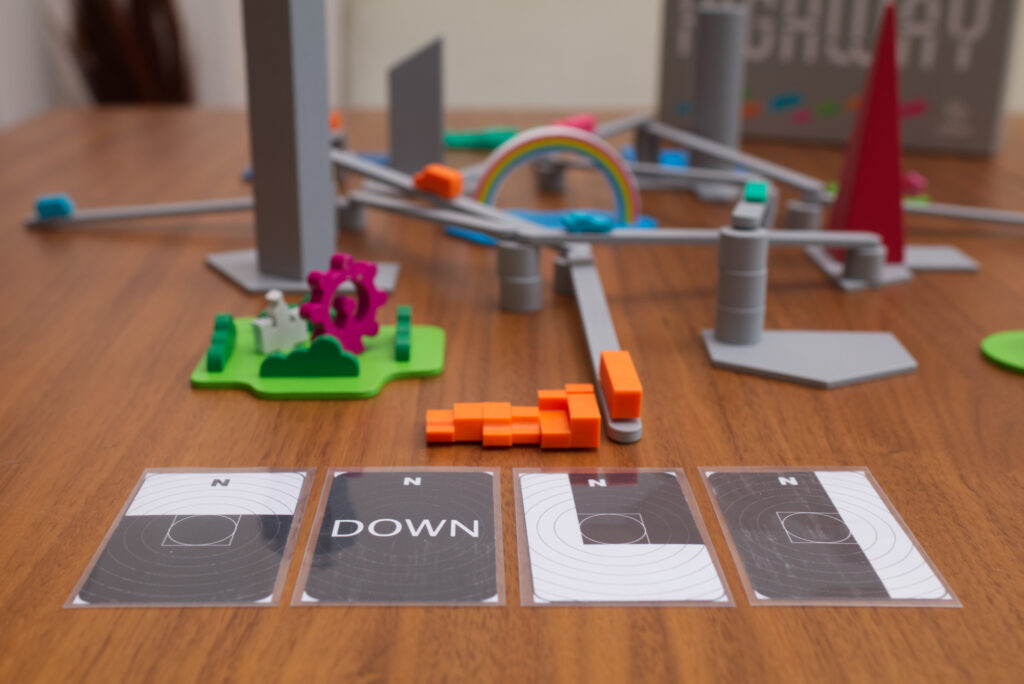
This simple mechanism works surprisingly well and it’s lots of fun to build ever more complex roads and try to maximise your scoring. Even if you don’t own Rainbow City but just the original game, I wholeheartedly can recommend picking this up. Often I don’t really care about what I score but just enjoy trying to get as many of my cars placed as possible.
Conclusion
When I backed it, I wasn’t sure if Rainbow city with its rubbery cars would really be an upgrade over the copy of the original game I already owned. However, having more obstacles is always fun and in combination with the excellent solo mode, I’m really happy I got Rainbow City. Despite having more content in it, the box is also a little bit smaller than my original copy, which is a plus for bringing this to a game night.
Having the rubber cars and end tips for the streets makes Tokyo Highway a little bit more strategic and a little bit less fiddly. The added stability and sneeze-resistance doesn’t hurt the game but makes it less stressful to play. This might or might not be what you want in a dexterity game. For chaotic fun, the wooden version is still what I would prefer. Overall though, I likely will sell my copy of the wooden version and just keep Rainbow City. I can see this getting much more often to the table now with my playgroup of rather mid-to-heavy players, plus I have a new solo game for when I want to turn my brain off and just do some fun building.
